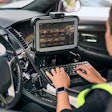The San Jose Police Department became the first law enforcement agency in the country to deploy head-mounted video cameras on officers during a pilot program started late last year. The department implemented the new TASER AXON and Evidence.com system.
The department equipped 18 officers with the AXON devices, which Chief Rob Davis told the San Jose Mercury News are a technological advance comparable to the advent of police cars, two-way radios and the 911 emergency system.
Only time will tell whether Davis' remarks are exaggerated, yet we can understand the chief's enthusiasm for the gadgets and accompanying Evidence.com evidentiary Web portal.
TASER International produces the AXON devices and hosts the digital evidence using its Evidence.com portal and is also funding the trial. Here's how the company describes the system's main benefit:
"Law enforcement officers constantly face false allegations and complaints that question their integrity and honor," according to the TASER Website. "With AXON, you now have the ability to show administrators and even jurors exactly what you saw, from your visual perspective."
The officer activates the AXON camera, which is attached by a headband above the officer's ear, each time he or she makes contact with a person. At the end of the officer's shift, the recording is downloaded to a central server. A small computer is attached to the duty belt.
The cameras align with the officer's vision and include an audio recording component. There are several recording modes, including standby, buffer and non-record. In buffer mode, limited segments of video are recorded and stored. It also includes infrared technology that enables recording in low-light conditions.
The officer can review the tape at any time, but can't erase it. Once uploaded to Evidence.com, the digital video footage can be stored for review and sharing by command staff.
This is where the system really seems to soar. Evidence.com uses geospatial mapping to present a 3D view of an agency's jurisdiction. Clicking on an incident icon on the map brings up the officer point-of-view footage.
Taking a cue from social media, the portal's User Interface offers sharing and advanced search functions that even includes a "cover flow" similar to what iPods use to display album art. The server can also store video from TASER cams, in-car video or user-uploaded content.
The system offers a high-ceiling of promise. We'll be keeping our eye on whether it can unlock these possibilities.














